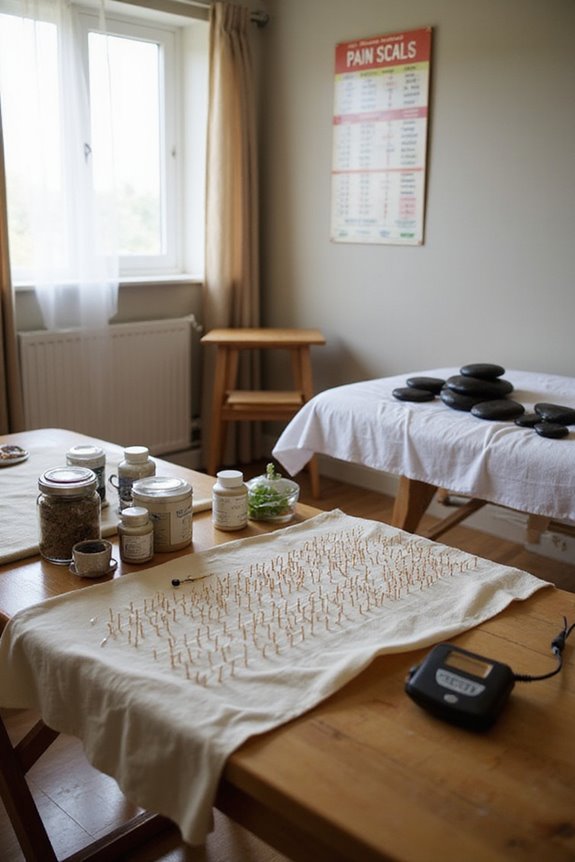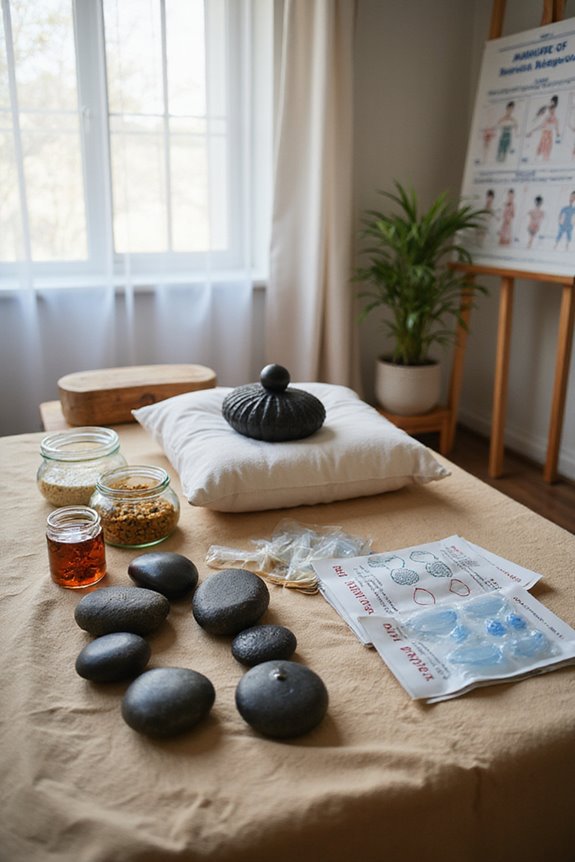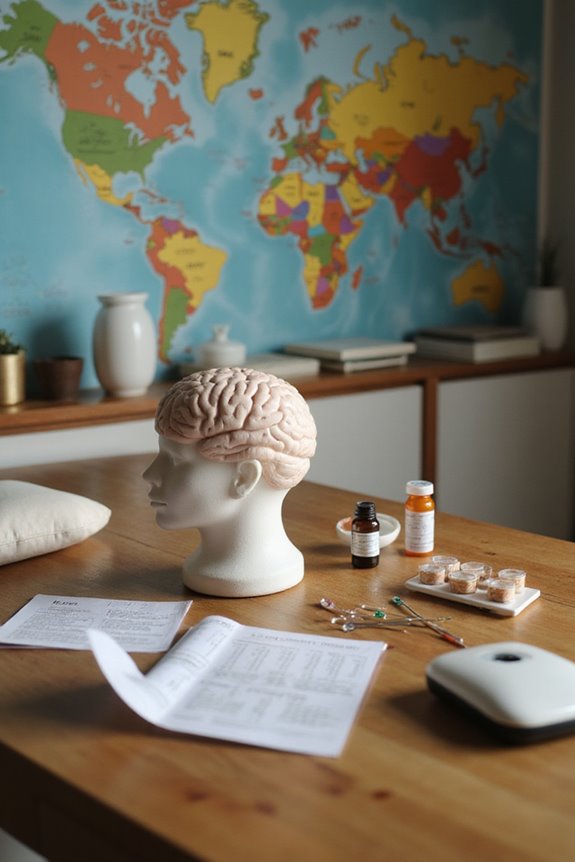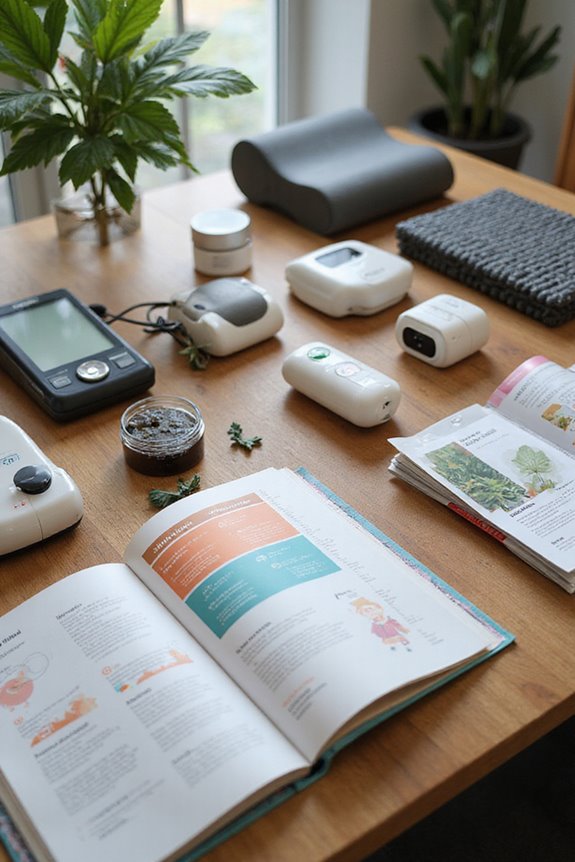Cultural beliefs notably influence pain perception, affecting expression and management. Key aspects include:
- Cultural Norms: Some cultures promote stoicism, minimizing reported pain.
- Chronic Pain Prevalence: Western countries report around 20% chronic pain, while developing nations range from 13% to 51%.
- Sociocultural Barriers: Language and health literacy impact pain communication and access to treatment.
- Pain Sensitivity: Genetic and environmental factors shape how pain is experienced.
Understanding these cultural dynamics is essential for addressing treatment disparities and improving care effectiveness. Further insights await exploration.
Key Takeaways
- Cultural beliefs shape how individuals interpret pain, viewing it as a test of faith or a normal aspect of life.
- Environmental factors and genetics intersect with cultural beliefs, influencing variations in pain sensitivity among different ethnic groups.
- Some cultures value stoicism, leading individuals to underreport pain and endure it silently rather than seek help.
- Spiritual interpretations of pain can affect healthcare decisions, with some believing pain is a moral trial or a natural part of aging.
- Language differences and cultural frameworks can create barriers to effective communication and understanding of pain management in healthcare settings.
Cultural Norms and Pain Expression
Cultural norms greatly influence the expression of pain across different societies.
- In some cultures, stoicism expression is highly valued, promoting endurance and a neutral demeanor even in the face of pain.
- Conversely, other cultures encourage open expression, viewing vulnerability as a means to seek social support.
These differing norms can notably impact an individual’s willingness to communicate pain levels or pursue medical help.
– Pain is often interpreted through cultural lenses, where it may be seen as a test of faith or a moral challenge.
Healthcare providers must be aware of these cultural differences to avoid misinterpretation of pain severity and to guarantee effective pain management strategies.
– Culturally sensitive approaches are essential for accurate assessment and treatment of diverse patient populations.
Chronic Pain Prevalence Across Cultures

Chronic pain prevalence varies considerably across different cultural contexts, reflecting not only the biological underpinnings of pain but also the socio-economic and healthcare frameworks in place.
- In Western countries, approximately 20% of adults report chronic pain, with higher rates among specific groups, such as older adults and those with lower socio-economic status.
- In the United States, about 20.9% of adults experienced chronic pain in 2021, with 6.4% facing high-impact chronic pain.
- Conversely, in developing countries, chronic pain prevalence ranges from 13% to 51%, with a pooled estimate of 18%.
- Global pain statistics indicate that around 1.5 billion individuals suffer from chronic pain, highlighting chronic pain disparities influenced by geographic and socio-economic factors.
Sociocultural Barriers in Pain Management

Effective pain management is often hindered by a variety of sociocultural barriers that affect patient-provider interactions. Key barriers include:
- Language and Communication: Language differences can lead to misinterpretation of pain, affecting treatment. Limited proficiency among healthcare providers may exacerbate these issues.
- Cultural Beliefs and Norms: Some cultures favor stoicism or traditional remedies, resulting in underreported pain and reluctance to seek biomedical treatment.
- Socioeconomic Disparities: Economic factors influence healthcare access, limiting availability of pain specialists and medications.
- Health Literacy: Low health literacy contributes to misunderstandings about pain management, fostering stigmas and fears surrounding treatment.
Addressing these sociocultural barriers is essential for improving pain management outcomes and ensuring equitable healthcare access for all patients.
Cultural Influence on Pain Sensitivity

Pain sensitivity is greatly influenced by a variety of cultural factors that shape individuals’ perceptions and responses to pain.
- Genetic predispositions can lead to variations in pain sensitivity across different ethnic groups, impacting pain threshold.
- Environmental factors, such as diet and lifestyle, intersect with genetic components to influence pain experiences.
- Cultural beliefs play a significant role; for instance, some cultures view pain as a natural healing process or a spiritual test, affecting emotional responses and coping strategies.
- These factors underscore the necessity for personalized, culturally sensitive pain management approaches.
- Recognizing these biological and cultural contributions is essential for addressing disparities in pain treatment outcomes among diverse populations, ensuring more effective healthcare interventions.
Pain Communication Variability

Cultural variability greatly influences how individuals communicate their experiences of pain.
- Pain Reporting: In certain cultures, especially Asian, individuals often report pain more stoically, minimizing its expression to avoid stigma.
- Communication Styles: Differences in verbal and nonverbal communication notably impact pain descriptions; some cultures rely on nonverbal cues rather than words.
- Language Barriers: Language differences can lead to misinterpretations, as nuances may be lost in translation.
- Cultural Conditioning: Societal values may condition individuals to understate pain, affecting the depth of pain communication.
- Healthcare Implications: Clinicians must possess cultural competence to accurately interpret pain reports, ensuring effective patient care and appropriate pain management strategies.
Cultural Interpretations of Pain Causes
Understanding the origins of pain is essential, as various cultures interpret pain causes through distinct lenses.
- Spiritual interpretations often view pain as a test of faith or a moral trial, rather than a mere physical symptom.
- In many societies, pain may be perceived as a natural aspect of life, aging, or even a rite of passage.
- Supernatural explanations, such as curses or divine punishment, can greatly influence perceptions of discomfort.
- Cultural frameworks dictate whether pain is regarded as an opportunity for healing or a medical issue needing intervention.
- For instance, in Nepal, back pain is typically accepted as a normal part of aging, affecting individual pain tolerance and healthcare decisions.
These beliefs shape the collective understanding of pain and its implications for treatment.
Frequently Asked Questions
How Do Cultural Beliefs Influence Pain Medication Adherence?
Cultural beliefs markedly shape medication beliefs and adherence behaviors. Understanding these influences allows healthcare providers to tailor approaches, enhancing communication and fostering trust, ultimately improving patient engagement and adherence to prescribed pain management regimens.
Can Cultural Attitudes Shape Pain Coping Strategies?
Cultural attitudes considerably shape pain coping strategies, with cultural rituals providing essential support networks. These coping mechanisms foster resilience and community bonding, enabling individuals to navigate their pain experiences through shared beliefs and practices.
Are There Cultural Differences in Pain-Related Humor?
Cultural differences in pain-related humor greatly influence its effectiveness for pain relief. Western cultures embrace humor as a coping mechanism, while Eastern cultures often reserve humor for unique contexts, affecting its therapeutic potential in stressful situations.
How Do Family Dynamics Affect Pain Perception Across Cultures?
Family dynamics greatly influence pain perception across cultures, as family communication styles and emotional support shape how individuals express and interpret pain, impacting treatment-seeking behaviors and adherence to medical advice within familial contexts.
What Role Does Gender Play in Cultural Pain Expression?
Gender greatly governs cultural expectations and stereotypes surrounding pain expression. These societal standards shape behaviors, compelling men to mask discomfort while encouraging women to vocalize suffering, ultimately influencing pain perception and healthcare interactions.




